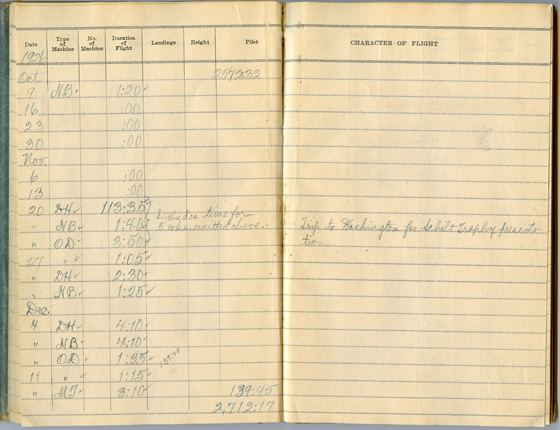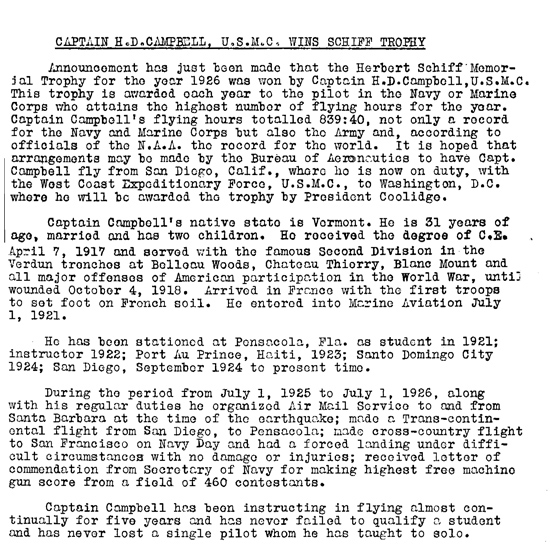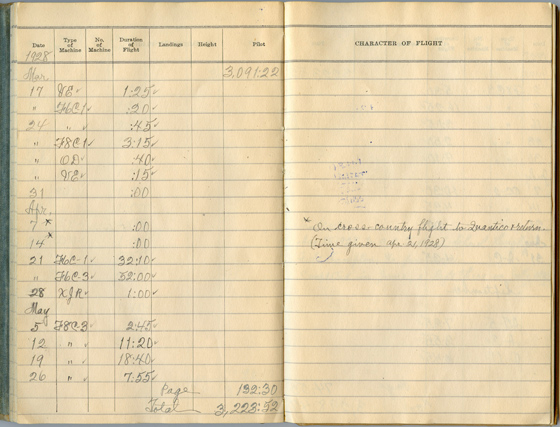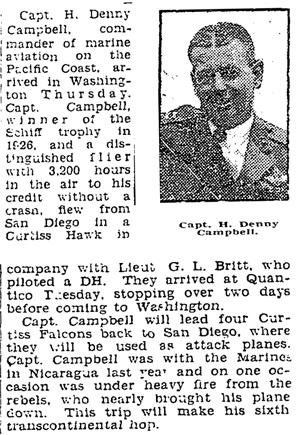|
Harold Campbell, a U.S. Marine Corp pilot based at San Diego, CA, signed the Davis-Monthan Register four times. There is no biographical file for him at the Smithsonian. However, his pilot log books are maintained at the archives of the San Diego Aerospace Museum where I was allowed to scan them during February, 2006.
The main artifacts that I have documenting his passage through Tucson are a copy of a couple of pages of his pilot log book and the following news article from the Mexia, TX Daily News of October 5, 1926. The article, his pilot log and the Register all point to an instant in the life of pilot Campbell.
Mexia Daily News, October 5, 1926
 |
Mexia Daily News, October 5, 1926, Cont.
 |
Donor Mike Gerow says of the airplane shown in the article, it, "...looks like a Lewis & Vought VE-7 Bluebird." This is not the airplane he flew to Tucson. The article summarizes Campbell's WWI experience.
Campbell's first landing at Tucson was on Sunday, October 10, 1926. He was flying a deHavilland DH-6, A-6380 (note that Joe Baugher's site identifies aircraft bureau numbers A-6352 through 6401 as DH-4B-1 Liberty planes transferred from the War Dept. to the U.S. Navy).
Regardless, Campbell carried a single passenger, one MSgt. Henderson. They were eastbound to El Paso, TX and wrote in the Remarks column of the Register, "For Wash, DC".
Below is Campbell's pilot log page that coincides with his visit to Tucson. It, and the Mexia, TX news article, document very well the context and purpose of his flight to Tucson.
Notice from October 9th through the next five weeks he records no hours. He waited until the third week of November to tally the hours for his cumulative flight activity in deHavilland ("DH") airplanes over those five weeks. He notes that his cumulative time, "Includes time for 5 wks. omitted above. Trip to Washington for Schilt [sic] Trophy presentation." He misspelled "Schiff" perhaps thinking of his fellow Marine aviator Frank Schilt.
The 100+ hours in deHavilland aircraft undoubtedly includes the cross-country segments to Washington, DC. We note that by the end of December, 1926 he had accumulated 2,712 hours and 17 minutes of flight time.
Harold D. Campbell Pilot Log, October, 1926
 |
The award of the Schilt Trophy, and the cross-country flight during which he landed at Tucson, are documented further in this REFERENCE. (p. 39) as follows.
"At least one Marine aviator was successful in his safety program. Captain Harold D. Campbell received the Schiff Trophy, the annual air safety award, for having flown 839.50 accident-free hours during the fiscal year 1925-1926 . For presentation of the trophy by the President of the United
States, Captain Campbell flew from San Diego to Washington, D .C., a flight which was still an
accomplishment in itself in 1926." |
Another article documenting this award is from the Bureau of Aeronautics Newsletter of September 25, 1926, as follows. This brief article gives some insight into pilot Campbell's personal life, as well as his military achievements in the Marine Corps.
Bureau of Aeronautics Newsletter, September 25, 1926
 |
His second visit was on Monday, August 8, 1927. He was on a round-robin flight to Tucson from San Diego in deHavilland A-6911. He carried a single passenger, a Mr. Carr. They remained overnight, departing next morning at 8:00AM for their return to San Diego.
His third, solo, visit was on Saturday, March 24, 1928 in Curtiss Hawk A-6972. Please follow the link to be directed to an image of this airplane. His destination was identified as Quantico, VA. He was flying with fellow pilot G.M. Britt in a deHavilland (see below).
His final signature in the Register was on Thursday, April 19, 1928. He was flying A-7961 which he identified as a Curtiss Falcon (Baugher identifies A-7949 through 7969 as Curtiss F8C-3 Falcons, all redesignated as OC-2). He carried a Cpl. Collier. His log book for this date is below. In a similar fashion, he summarized his hours.
Harold D. Campbell Pilot Log, April, 1928
 |
His flight through Tucson with Cpl. Collier was the finish of his cross-country trip from San Diego to Quantico, VA begun on March 24th. Cryptically, In the Remarks column, he noted, "Love and Kisses."
Washington Post, April 1, 1928
 |
The overall purpose of that cross-country flight was not recorded in the Register. However, an article in the Washington Post of April 1, 1928 (left) explains his presence at Tucson. He was part of a group ferrying new Curtiss Falcons to the west coast. The article states four new airplanes. Three of these (A-7961, A-7962 and A-7968) are captured in the Register on Thursday, April 19th. The pilot of A-7962 was Glenn M. Britt. The pilot of A-7968 was Walter Lee Pounders.
It is rare that we can place pilots and airplanes at Tucson and divine their whereabouts and purpose with such "complete" supporting data. In this case we have not only the Register entries, but also a pilot flight log and a contemporary newspaper account. Life is good when this happens!
We can visualize his solo voyage to Quantico, perhaps some training duties over the month while there, the swap of airplanes and addition of a passenger for the return trip.
We note that by the end of May, 1928 he had accumulated 3,223 hours and 52 minutes of flight time. His total time for the 17 months between the two pages above is therefore about 511 hours (about 30 hours per month).
Later in the mid-1930s, the Marine Corps developed a unified doctrine for the conduct of amphibious operations. Campbell's role is documented in this REFERENCE (p. 65) as follows.
| "During late 1933 and early 1934, the instructors and students at the Marine Corps Schools, in consultation with officers from Headquarters Marine Corps ... drew up the Tentative Landing Operations Manual . This document, published by the Navy Department in 1935, laid out in detail the principal steps for conducting an amphibious assault . The concepts of command relationships, organization, fire support, assault tactics, ship-to-shore movement, and logistics outlined in the manual and refined in edition after edition were tested and improved in fleet exercises during the 1930s. In World War II, they guided Marines to their hard-won Pacific victories. The aviation section of this famous manual was written by a group of Marine fliers headed by Captain Harold D. Campbell." |
This doctrine was put to good use in the Pacific. In fact, during WWII, after September 15, 1944 and the invasion of Peleliu under the code name operation "Stalemate", then Brig. Gen. Campbell and his 2nd Marine Air Wing were tasked with moving Marine aviation to Peleliu. Ten years earlier he had literally written the book on how to do just that.
A year earlier, from this REFERENCE, page 39, a "... joint bomber strike against Tarawa was launched in September 1943 in an attempt to neutralize the airfield there, thereby preventing interference to the engineers building the airfields on the three Ellice Islands .... Brigadier General Harold D. Campbell, USMC, of the Funafuti Air Group boasted B-24s, PBYs, and PV-1s for the raid."
---o0o---
UPLOADED: 02/14/09 REVISED: 02/22/09, 07/17/09, 10/26/15
|







